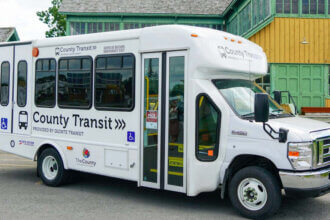Commute to Work
Prince Edward County, Ontario, Canada.
Vital Signs Data

Updated December 29, 2023
Commute to work
As of 2021, driving was the most common mode of transportation (91.3 percent), followed by walking (5.5 percent). Public transit launched in August 2020 during the pandemic and in the census data collection year. Viable transportation options for cyclists are being developed through the Cycling and Transportation Master Plan.
| Commute | 2006 | 2011 | PEC 2016 | PEC 2021 | Ontario 2021 |
|---|---|---|---|---|---|
| Car, truck, van, as driver | 81.1% | 85.9% | 86.3% | 84.7% | 83.6% |
| Car, truck, van, as passenger | 9.6% | 5.5% | 5.3% | 6.6% | 7.5% |
| Walked or bicycled | 6.9% | 6.0% | 6.2% | 5.9% | 5.4% |
| Public transit | 0.8% | 1.3% | 1.0% | 0.2% | 8.6% |
| Worked at home | 12.9% | 11.0% | 13.2% | 27.6% | 29.7% |
| Commute within census subdivision (CSD) of residence | 39.9% | -- | 44.1% | 57.9% | 58.7% |
| Commuting distance, less than 15 minutes | -- | -- | 31.6% | 33.5% | 28.3% |
Remote work / Telework
Remote work in Canada increased during the Covid-19 pandemic to 40% in late March 2020, up from 13% in 2018. A 2021 KPMG survey discovered that over three in four (77 percent) Canadians like the idea of a hybrid workplace model.
Historically, even prior to the pandemic, PEC has a higher percentage of people working from home (13.2%) than Ontario (7.3%).

The pandemic and working remotely has also shifted attitudes about commuting — nearly a third of Canadians want a commute of no more than 15 minutes. (Angus Reid, The 15 Minute Commute) 33.5% of PEC workers have commute durations of less than 15 minutes compared to Ontario at 28.3%. Not only are PEC commute times shorter, but the PEC scenery and generally quiet roads make the drive enjoyable.
The flexibility to work from any location is inspiring people to relocate from heavily populated urban areas to rural areas. This trend has driven up the demand for real estate in rural areas such as Prince Edward County. Four in ten Canadians work in jobs that can be done remotely. (Statistics Canada, StatCan COVID-19, Running the economy remotely: Potential for working from home during and after COVID-19)
Pros
- There is potential to reduce air pollution as fewer people commute to work.
- More options for remote work and services help to remove barriers for people with disabilities or challenges such as childcare, transportation or distance.
- Rural regions with limited employment opportunities can benefit from migration of remote workers into their communities.
Cons
- Workers at the bottom of the earnings distribution have less opportunity for telework and greater risk of job automation.
- The lack of reliable internet access for rural residents and businesses across Eastern Ontario has been exposed by COVID-19.
- Commercial office space and the “ecosystem” of local businesses that rely on occupied office buildings are negatively affected.
Sustainable Development Goal (SDG)
SDG 11.2 Provide access to safe, affordable, accessible and sustainable transport systems for all, with special attention to the needs of those in vulnerable situations.
Also see …
Transportation
Lack of public transportation has been cited as…
Commute to Work
Public transit use may be positively impacted by…
Transportation: Collaborative Impact
Getting Around Transportation Collective vision: An integrated transportation…
Transportation – Actions
Public Transportation: Advancing well-being together








